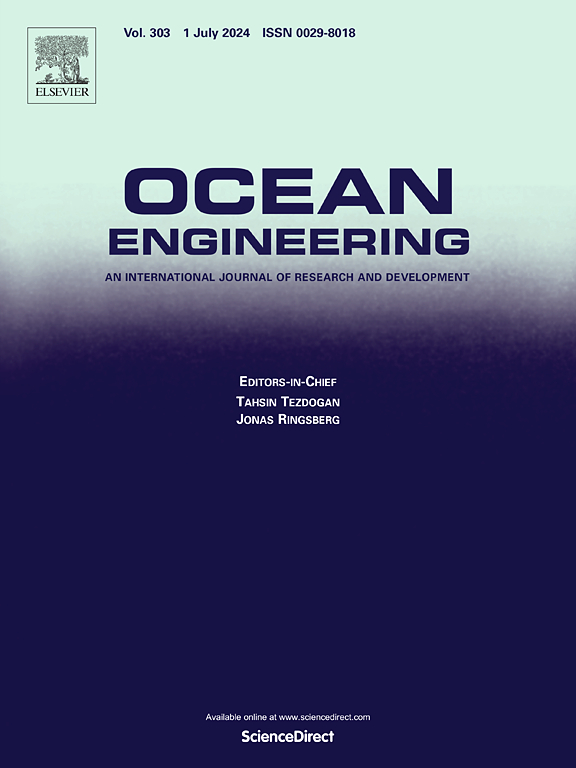Hydrodynamic performance of a forward bent duct buoy oscillating water column wave energy converter
IF 4.6
2区 工程技术
Q1 ENGINEERING, CIVIL
引用次数: 0
Abstract
This study investigated the hydrodynamic performance of the forward bent duct buoy oscillating water column (FBDB-OWC) wave energy converter (WEC), focusing on the effects of side-wall angle, bottom-wall angle, top-wall angle and corner radius. Using three-dimensional numerical modeling based on computational fluid dynamics, this research evaluated the hydrodynamic performance through the pressure drop, airflow rate and free surface inside the chamber, and assessed the energy conversion efficiency of the converter. The results indicate that the side-wall angle of the duct has a minimal effect on capture width ratio. The bottom-wall angle significantly improves the energy conversion efficiency, while modifications to the top-wall angle offer additional gains. When both wall angles are set to 25°, the FBDB configuration achieves a substantial increase in wave energy capture, with an 84.4 % pneumatic power increase compared to the configuration without angled walls. Additionally, an optimal corner radius further enhances energy conversion, leading to a 125.9 % increase in the capture width ratio relative to the FBDB converter without angled walls and rounded corners. These findings offer crucial insights for the optimization of FBDB-OWC WEC designs, contributing to improved energy capture efficiency and overall performance.
前弯浮筒振荡水柱波能转换器的水动力性能
研究了前弯管浮筒振荡水柱(FBDB-OWC)波浪能转换器(WEC)的水动力性能,重点研究了侧壁角、底壁角、顶壁角和转角半径的影响。采用基于计算流体力学的三维数值模拟方法,通过压降、气流速率和室内自由面对转化器的水动力性能进行了评价,并对转化器的能量转换效率进行了评价。结果表明,风管的侧壁角对捕获宽度比的影响很小。底壁角度可以显著提高能量转换效率,而对顶壁角度的调整可以提供额外的增益。当两个壁角都设置为25°时,FBDB配置实现了波浪能量捕获的大幅增加,与没有倾斜壁的配置相比,气动功率增加了84.4%。此外,最佳的拐角半径进一步提高了能量转换,相对于没有角壁和圆角的FBDB转换器,捕获宽度比增加了125.9%。这些发现为优化FBDB-OWC WEC设计提供了重要见解,有助于提高能量捕获效率和整体性能。
本文章由计算机程序翻译,如有差异,请以英文原文为准。
求助全文
约1分钟内获得全文
求助全文
来源期刊

Ocean Engineering
工程技术-工程:大洋
CiteScore
7.30
自引率
34.00%
发文量
2379
审稿时长
8.1 months
期刊介绍:
Ocean Engineering provides a medium for the publication of original research and development work in the field of ocean engineering. Ocean Engineering seeks papers in the following topics.
 求助内容:
求助内容: 应助结果提醒方式:
应助结果提醒方式:


